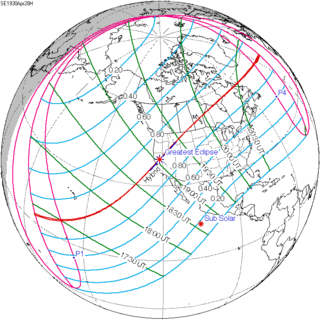A total solar eclipse occurred on April 28, 1930. A solar eclipse occurs when the Moon passes between Earth and the Sun, thereby totally or partly obscuring the image of the Sun for a viewer on Earth. A total solar eclipse occurs when the Moon's apparent diameter is larger than the Sun's, blocking all direct sunlight, turning day into darkness. Totality occurs in a narrow path across Earth's surface, with the partial solar eclipse visible over a surrounding region thousands of kilometres wide. This event is a hybrid, starting and ending as an annular eclipse.
| Solar eclipse of April 28, 1930 | |
|---|---|
| Type of eclipse | |
| Nature | Hybrid |
| Gamma | 0.473 |
| Magnitude | 1.0003 |
| Maximum eclipse | |
| Duration | 1 s (0 min 1 s) |
| Coordinates | 39°24′N 121°12′W / 39.4°N 121.2°W |
| Max. width of band | 1 km (0.62 mi) |
| Times (UTC) | |
| Greatest eclipse | 19:03:34 |
| References | |
| Saros | 137 (31 of 70) |
| Catalog # (SE5000) | 9351 |
The path of totality crossed the eastern Pacific Ocean, northwestern United States, central and eastern Canada, and northern Labrador of the Dominion of Newfoundland (today's Newfoundland and Labrador in Canada).
Related eclipses edit
Solar eclipses 1928–1931 edit
This eclipse is a member of a semester series. An eclipse in a semester series of solar eclipses repeats approximately every 177 days and 4 hours (a semester) at alternating nodes of the Moon's orbit.[1]
| Solar eclipse series sets from 1928 to 1931 | ||||
|---|---|---|---|---|
| Ascending node | Descending node | |||
| 117 | May 19, 1928 Total (non-central) |
122 | November 12, 1928 Partial | |
| 127 | May 9, 1929 Total |
132 | November 1, 1929 Annular | |
| 137 | April 28, 1930 Hybrid |
142 | October 21, 1930 Total | |
| 147 | April 18, 1931 Partial |
152 | October 11, 1931 Partial | |
Saros 137 edit
It is a part of Saros cycle 137, repeating every 18 years, 11 days, containing 70 events. The series started with partial solar eclipse on May 25, 1389. It contains total eclipses from August 20, 1533, through December 6, 1695, first set of hybrid eclipses from December 17, 1713, through February 11, 1804, first set of annular eclipses from February 21, 1822, through March 25, 1876, second set of hybrid eclipses from April 6, 1894, through April 28, 1930, and second set of annular eclipses from May 9, 1948, through April 13, 2507. The series ends at member 70 as a partial eclipse on June 28, 2633. The longest duration of totality was 2 minutes, 55 seconds on September 10, 1569. Solar Saros 137 has 55 umbral eclipses from August 20, 1533, through April 13, 2507 (973.62 years).
| Series members 30–40 occur between 1901 and 2100: | ||
|---|---|---|
| 30 | 31 | 32 |
| April 17, 1912 |
April 28, 1930 |
May 9, 1948 |
| 33 | 34 | 35 |
| May 20, 1966 |
May 30, 1984 |
June 10, 2002 |
| 36 | 37 | 38 |
| June 21, 2020 |
July 2, 2038 |
July 12, 2056 |
| 39 | 40 | |
| July 24, 2074 |
August 3, 2092 | |
Inex series edit
This eclipse is a part of the long period inex cycle, repeating at alternating nodes, every 358 synodic months (≈ 10,571.95 days, or 29 years minus 20 days). Their appearance and longitude are irregular due to a lack of synchronization with the anomalistic month (period of perigee). However, groupings of 3 inex cycles (≈ 87 years minus 2 months) comes close (≈ 1,151.02 anomalistic months), so eclipses are similar in these groupings.
| Inex series members between 1901 and 2100: | ||
|---|---|---|
| May 18, 1901 (Saros 136) |
April 28, 1930 (Saros 137) |
April 8, 1959 (Saros 138) |
| March 18, 1988 (Saros 139) |
February 26, 2017 (Saros 140) |
February 5, 2046 (Saros 141) |
| January 16, 2075 (Saros 142) |
||
Notes edit
- ^ van Gent, R.H. "Solar- and Lunar-Eclipse Predictions from Antiquity to the Present". A Catalogue of Eclipse Cycles. Utrecht University. Retrieved 6 October 2018.
References edit
- Earth visibility chart and eclipse statistics Eclipse Predictions by Fred Espenak, NASA/GSFC
- The solar eclipse of April 28, 1930 Popular Astronomy, Vol. 38, p. 537, Makemson, Maud W. [1]
- The Central Solar Eclipse of April 28, 1930 Journal of the Royal Astronomical Society of Canada, Vol. 24, p. 55 [2]
